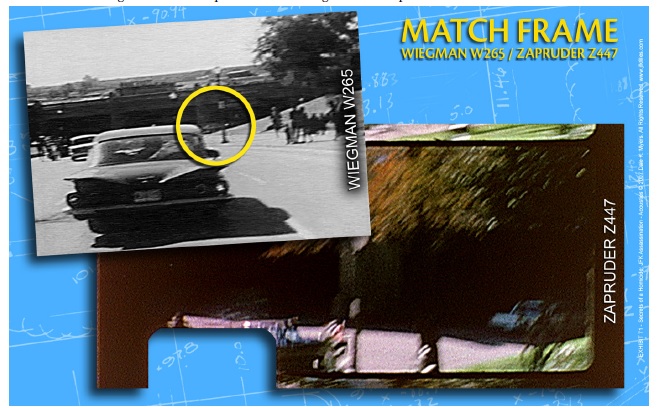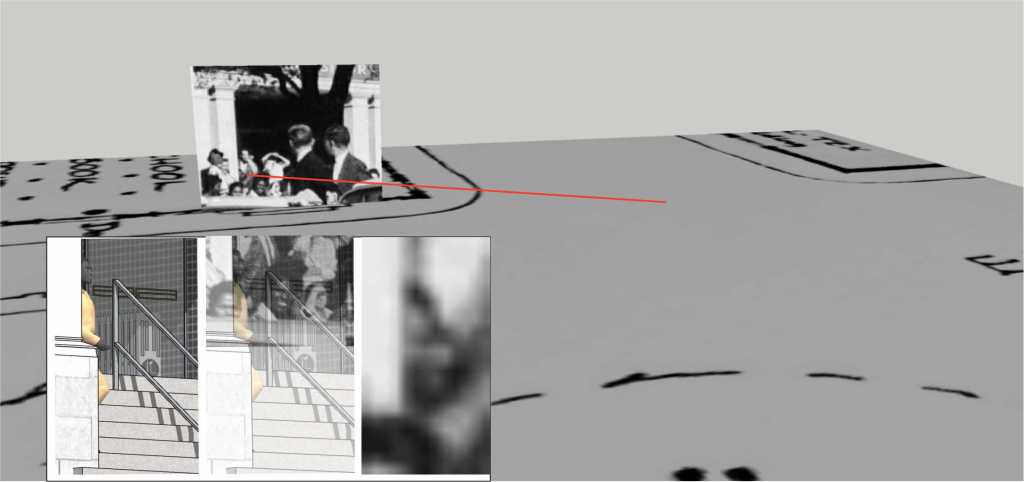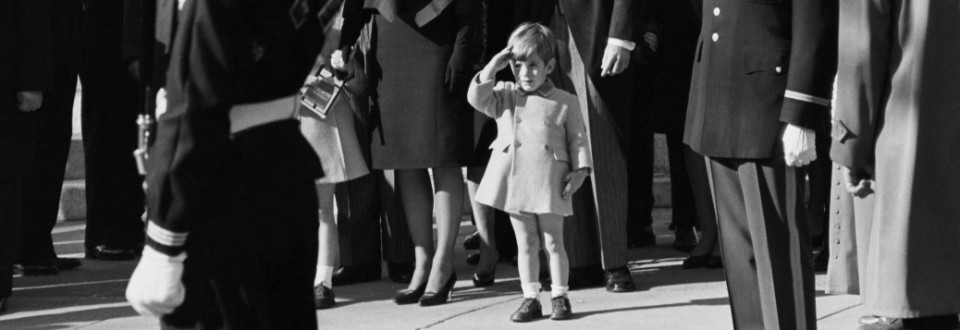Dale Myers published a timing analysis of amateur films recorded during assassination of President Kennedy, and synchronised each film with Zapruder film, with Zapruder film providing a common time base [1]. The present article challenges the continuity of frames in Zapruder film based on the disparities in the scenes seen in Wiegman film and Altgens6 photograph.
Let me begin with the timing of Altgens6 photograph. It has been proposed that Altgens6 picture was taken around frame Z255 of Zapruder film [2]. Figure 1 shows Altgens6 picture and three frames: Z254, Z255, and Z256. While all three Zapruder film frames offer very similar views of the car and car occupants, and Altgens6 give little details of the inside of the car, it is possible to identify the correct frame by zooming on the U.S flag in the right front fender of the car. Only Z255 offers the same folds seen on the flag as Altgens6. Thus, the interim conclusion is that Altgens6 was captured at the instant corresponding to frame Z255, in agreement with prevailing views.
Figure 1: Time stamping of Altgens6 on a time scale of Zapruder film frames. The shape of the U.S. flag on the right front fender of President’s limousine in Altgens6 (right black-and-white picture) was compared to the shapes in Zapruder film frames 254, 255, and 256. The folds seen on the flag seen in Altgens6 photograph matched the frame Z255.

The NBC cameraman Dave Wiegman was sitting on the top edge of the right front door of car #8 when shots rang out [2]. Wiegman started filming while still in the car but soon jumped out of the car and continued filming as the motorcade moved toward the Tripple Underpass. Wiegman film is about 36.5 s long; at a 24 Hz frame rate [1, p. 96], the film would have about 876 frames. Importantly, Wiegman was shooting continuously which means that this film offers an independent time base of events.
Myers’s synchronisation of Wiegman and Zapruder film rested on matching Wiegman frame W265 with Zapruder film frame Z447 in which President’s limousine was approaching the Tripple Underpass. This synchronisation was based on drawing lines-of-sight from Wiegman’s and Zapruder’s locations and matching them against a lamppost on the northern side of Elm Street, closest to President’s limousine. Figure 2 shows a reproduction of the relevant figure from Mr. Myers’s article [1].
Figure 2: The event used by Dale Myers to synchronise Wiegman film with Zapruder film. Location of President’s limousine relative to the lamppost closest to the tripple underpass and the lines-of-sight of Zapruder and Wiegman (not shown) were used to co-locate frames Z447 and W265. From: Myers, D.K., Secrets of a Homicide [1], page 98.

The time difference between fames Z447 and Z255 was 10.49 s, or 192 frames, assuming an 18.3 Hz frame rate of Zapruder camera. Counting back from the instant Z447/W265 when both films were showing the same location of President’s limousine according to Myers’s analysis [1], the period of 10.49 s would cover 251.8 frames of Wiegman film, rounded to 252 frames. The zero frame in Wiegman film preceded the instant Z255 by 13 W-frames and therefore, Wiegman would need to start filming 0.54 s (13 frames in Wiegman film or 10 frames in Zapruder film) before Z255 should both films meet at frame Z447/W265. In Wiegman’s own words [2], Wiegman started filming while still in car #8, however, he was not sure if he started to record before or after the second shot which according to Warren Report was the shot that hit President Kennedy’s back.
The timeline presented above suggests that the scenes seen in Altgens6 and Wiegman film should match in at least one frame, with Wiegman frame W13 being the strongest candidate for being a match with Altgens6. Let us inspect the Depository doorway which is visible in both Altgens6 and Wiegman film. The people standing in the doorway in frame W13 should show locations and postures identical to those seen in Altgens6. Wiegman film frame W13 is shown in in Figure 3. The left panel shows the frame W13 in a YouTube version of the film [3]; a better-quality still of the adjacent frame W12 frame is shown in the right panel [4].
Figure 3: Wiegman film frame W13 in the video file available on YouTube.com [3] (left) and a better-quality still of frame W12 downloaded from jfkassassinationgallery.com [4].

Figure 4 shows a cropped view of the Depository doorway in Altgens6 (left) and Wiegman frame W12. Altgens6 picture is a high-resolution version of the photograph bearing a label: Robert Groden – “JFK-Absolute Proof”. Both images have been aligned in such a way that the figures of three persons standing on the top steps matched in both stills. The legend to Figure 4 explains the differences between Algens6 and Wiegman still: a) the body orientation, posture and direction of gaze in Carl Jones’s figure (the Afro-American man standing at the front western pillar). b) direction of gaze and probably of trunk in Bill Shelley’s figure (the man standing on the top landing and wearing a suit and a tie). c) The location of Sarah Stanton possibly changed as well during the time elapsing between the instant when Altgens6 picture was snapped and Wiegman film frame W12. This difference is illustrated in Figure 5. The composite Figure 6 shows the lines of sight of Carl Jones and Bill Shelley in a 3D composition of 2D doorway scenes projected onto an area plan of Dealey Plaza. There could be also small changes in Billy Lovelady’s and Otis Williams’s locations; however, a confirmation of changes in their locations would require a 3D model of the Wiegman doorway scene which is currently not available to this writer.
Figure 4: Cropped views of the Depository doorway in Altgens6 (left) and Wiegman still W12 (right). The two photographs have been aligned in such a way that three people standing on the top steps were of approximately the same size in both stills. The lower panel shows the same pair of images as the top panel but also highlights the contours indicating the differences between Altgens6 and Wiegman still doorways: a) Carl Jones standing at the western wall of the doorway is facing east and has his back parallel to the western wall of the doorway in Altgens6 (red contour); the same man has his body orientated in parallel with the steps and gazes in general area of Tripple Underspass in Wiegman (orange contour). b) Bill Shelley, the man wearing a dark suit and a tie has his gaze orientated eastward in Altgens6 (red contour) but westward in Wiegman still (orange contour). The lower panel also highlights with blue dotted lines the very blurred contours of Buell Wesley Frazier’s head and Sarah Stanton’s hair. Only faint, residual spots corresponding to the figures of these two people can be seen in Wiegman frame and therefore, no strong conclusions can be drawn from their locations. Buell Wesley Frazier cannot be seen in Altgens6, while Sarah Stanton has been suggested to stand in the space between Billy Lovelady and Bill Shelley in Altgens6 [5]. Mrs. Stanton appeared to have slipped behind Bill Shelley in Wiegman film, and her presence there can be inferred from a light-coloured shape above Bill Shelley’s head, also seen in Darnell film (Figure 5).


Figure 5: Comparison of locations of Sarah Stanton in Altgens6 photograph (top left), Wiegman frame W12 (top middle), and Darnell still (top right). In Altgens6, a light-coloured oval hape is seen between the heads of Billy Lovelady and Bill Shelley in the original picture (left-hand part of the top left inset). This oval shape and other minor details were used to fit the figure of Mrs Stanton into the doorway scene to explain the presence of the partial face (right-hand part of the top left panel). According to this analysis [5], Sarah Stanton stood behind Billy Lovelady and just in front of Bill Shelley’s right shoulder in Altgens6 picture. Notably, Sarah Stanton had thick, light-coloured (blonde?) hair evidenced in the family photograph (bottom left) in which she is seen standing with her son Larry [6]. In Darnell still (right-hand panels), Mrs. Stanton’s figure can be identified according to the light-coloured shape above Bill Shelley’s head (top right). This rectangular light-coloured shape corresponded to the front face of Sarah Stanton’s hair volume (bottom left); please note that the top of Mrs. Stanton’s light-coloured hair crosses the level of Buell Wesley Frazier’s and Larry’s noses (highlighted with yellow dot line in the bottom panels) which corresponded to a body height of approximately 5′ 7”. In Wiegman film, a blurry, light-coloured shape is also seen in the area above Bill Shelley’s head. This writer proposes that Mrs. Stanton moved from her Altgens6 location just behind Billy Lovelady to a spot behind Bill Shelley during the period of several seconds that has elapsed between the instant when Altgens6 picture was taken and the beginning of Wiegman film. The purple line in the bottom panels delineate the heights of Buell Wesley Frazier’s and Stanton’s son Larry’s heads. These two men were of the same body height (6′ – 6′ 1”). This detail supports the identification of Sarah Stanton’s location in Darnell and Wiegman stills because the height of the light-coloured shape above Shelley’s head in both stills was appropriate relative to Larry’s and Buell Wesley Frazier’s figures. Please note that Wiegman film offeres very little information in dark tones, especially in the back of the doorway. Therefore, the figure of Buell Wesley Frazier is difficult to locate in Wiegman film. In contrast, the light-coloured tones were emphasised in Wiegman film which offered the possibility to identify a light-coloured shape of Sarah Stanton’s hair as a blurry light-coloured patch above Bill Shelley’s head.

Figure 6: Line-of-sight of Carl Jones in Altgens6 photograph (top panel) and Wiegman still (bottom panel). In the top panel, a cropped image of Depository doorway in Altgens6 was overlaid onto a 2D plan of Dealey Plaza. Carl Jones’s head was orientated toward a broad area of the intersection of Houston and Elm street, and the red line indicates the line-of-sight of Carl Jones at the moment when Altgens6 picture was taken. The insets showed a magnified view of Carl Jones’ head (right) with a superimposed 3D model of his figure (middle), and the full model (left). The bottom panel shows a cropped view of Wiegman still with a prominent figure of Carl Jones leaning onto the western pillar of Depository doorway. His body is now orientated 90 degrees relative to how he stood in Altgens6, and he seems to gaze in broad direction of Tripple Underpass. The inset in the lower panel shows a magnified and sharpened image of Carl Jones.


To explore other frames from the short sequence of Wiegman film in which his camera had a view of the Depository doorway, selected frames of Wiegman film are displayed in Figure 7. The left-hand column shows Wiegman frames extracted from the YouTube video, and the middle column their high-resolution version downloaded from jfkassassinationgallery.com. The right-hand column shows the cropped and enhanced views of the Depository doorway.
Figure 7: Overview of selected frames in Wiegman film. The left column shows three frames: W1, W16 and W29, representing the time instants 0.041s, 0.67 s, and 1.21 s, respectively. The middle column shows the better-quality stills of the same three frames downloaded from jfkassassinationgallery.com [7]. The right-most column shows cropped views of the Depository doorway and/or enlargement of Carl Jones’s figure. In all three frames, Carl Jones stood with his shoulders parallel to the steps, unlike in Altgens6. In frame W1 but not in frames W16 and W29, Carl Jones appears to have his gaze orientated toward Elm street. This analysis used frames for which a better-quality versions were available. Note: the better-quality still in the top column appears to have occurred one frame earlier than frame W1 obtained from extant version of Wiegman film.

The analysis of doorway scenes seen in Altgens6 and frame W12 and the rest of Wiegman film frames (only selected frames shown here) allows for the following conclusions: a) Not a single frame in Wiegman film shows a doorway scene that would be identical to Altgens6 doorway scene. This finding contradicts the temporal integrity of Zapruder film because the synchronisation of the two films by Dale Myers [1] required that Wiegman started filming at Zapruder frame Z245, hence at least one Wiegman frame should match Altgens6 scene. b) The doorway seen in Wiegman film could only occur several seconds later than the instant at which James Altgens snapped his famous sixth photograph. Even a very simple movement of striate muscles, voluntary or involuntary, takes up to 0.18 s. For instance, duration of an eyeblink ranges from 0.12 to 0.17 s. Repetitive involuntary tremor movements of hands in Parkinson patients have a frequency of 6 Hz giving a period of one tremor movement of 0.17 s. A slow finger movement, such as voluntary extension and flexion of index finger lasts just under 2 s [8]. Of course, more complex whole-body movements involving limbs and trunk would take longer than moving a small body part such as finger. In my tests, the time required to turn whole body around 90 degrees was approximately 2 s. A 2-second period required to see the change in Carl Jones’s body posture from the one seen in Altgens6 to the one in Wiegman film would be the minimum duration of the time gap between Altgens6 and the start of Wiegman film. If Sarah Stanton changed her estimated location between Billy Lovelady and Bill Shelley in Altgens6 to a location behind Bill Shelley in Wiegman film (Figure 5), the time needed to accomplish such transformation of the doorway scene would be longer than 2 seconds.
To conclude, analysis of the doorway scenes seen in Altgens6 and Wiegman film suggests that the timeline of events represented in Zapruder film was too short causing an improbable early start of Wiegman film preceding the instant at which Altgens6 was snapped. However, any of the doorway scenes depicted in Wiegman film frames occurred seconds later than the scene seen in Altgens6, questioning the temporal integrity of Zapruder film. This shortening of Zapruder timeline can only be explained if an unknown but significant number of frames were deleted from Zapruder film.
Footnotes:
[1] Myers, D. K. (2007) Secrets of a Homicide: The JFK Assassination Epipolar Geometric Analysis of Amateur Films Related to
Acoustics Evidence in the John F. Kennedy Assassination. Distributed by Oak Cliff Press, Inc., P.O. Box 608, Milford, MI 48381. Retrieved from: https://www.jfkfiles.com/jfk/html/report_download.html, 17/03/2023.
[2] Trask, R.B. Pictures of the Pain. Yeoman Press, Danvers, MA, 1994, pp. 371-373.
[3] Wiegman film: https://www.bitchute.com/video/eXV88Y158DOV/
[4] https://www.jfkassassinationgallery.com/displayimage.php?album=13&pos=4, digitalcollections_baylor (Credit:Jack White) Large
[5] The Case of a Missing Lady in Altgens6. https://www.youtube.com/watch?v=C0Hwt-cIGq4&t=9s
[6] Family picture of Sarah Stanton and her son Larry. Retrieved from: https://www.findagrave.com/memorial/152413470/sarah-juanita-stanton, on April 8, 2023.
[7] Wiegman stills downloaded from jfkassassinationgallery.com:
https://www.jfkassassinationgallery.com/albums/userpics/10001/normal_digitalcollections_baylor8.jpg https://www.jfkassassinationgallery.com/albums/userpics/10001/normal_1x.jpg https://www.jfkassassinationgallery.com/albums/userpics/10001/normal_PDVD_659.jpg
[8] Stancak, A., Pfurtscheller, G. (1996) The effects of handedness and type of movement on the contralateral preponderance of mu-rhythm desynchronization. Electroenceph. Clin. Neurophysiol., 99: 174-182.
